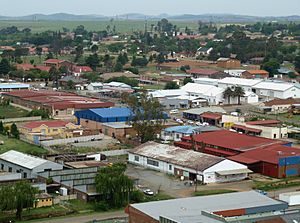Balfour, Mpumalanga facts for kids
Quick facts for kids
Balfour
|
|
|---|---|

Skyline photo of central Balfour
|
|
| Country | South Africa |
| Province | Mpumalanga |
| District | Gert Sibande |
| Municipality | Dipaleseng |
| Area | |
| • Total | 12.06 km2 (4.66 sq mi) |
| Population
(2011)
|
|
| • Total | 3,201 |
| • Density | 265.42/km2 (687.4/sq mi) |
| Racial makeup (2011) | |
| • Black African | 50.2% |
| • Coloured | 1.4% |
| • Indian/Asian | 9.4% |
| • White | 38.4% |
| • Other | 0.6% |
| First languages (2011) | |
| • Afrikaans | 5.6% |
| • Zulu | 60.7% |
| • English | 15.4% |
| • Sotho | 40.3% |
| • Other | 10.7% |
| Time zone | UTC+2 (SAST) |
| Postal code (street) |
2410
|
| PO box |
2410
|
| Area code | +27 17 773 |
Balfour is a growing town in Mpumalanga, South Africa. It is known for its gold mining and maize farming. This town is an important part of the local economy.
Contents
Discovering Balfour's Past
Balfour has an interesting history. It is located about 80 kilometers (50 miles) southeast of Johannesburg. The town was first established on two farms. These farms belonged to a man named Frederick Stuart McHattie.
How Balfour Got Its Name
In 1897, the town was first named McHattiesburg, after Frederick Stuart McHattie. It officially became a town on February 16, 1898. Later, on February 15, 1905, its name was changed to Balfour. This new name honored Arthur James Balfour. He was the Prime Minister of Great Britain from 1902 to 1905. He visited South Africa in the year the town was renamed.
Life in Balfour
Balfour is a small but active town. According to the 2011 census, about 3,201 people live there. The town covers an area of about 12 square kilometers (4.6 square miles).
Languages Spoken in Balfour
Many different languages are spoken in Balfour. The most common language is Zulu, spoken by over 60% of the people. Other languages include Sotho, English, and Afrikaans. This mix of languages shows the rich culture of the area.



